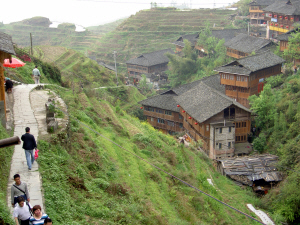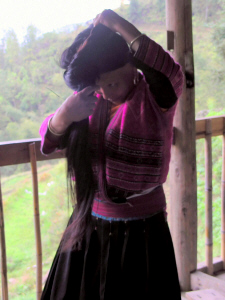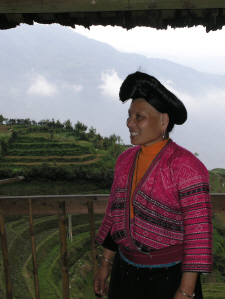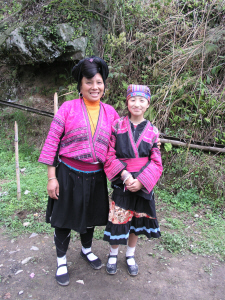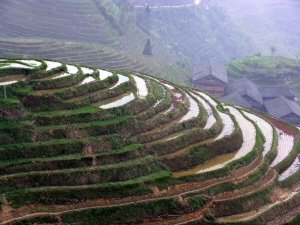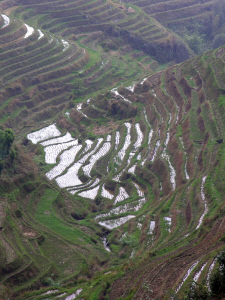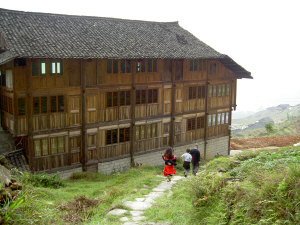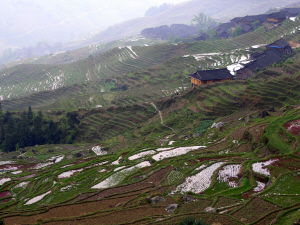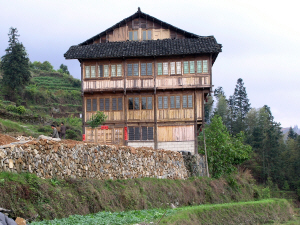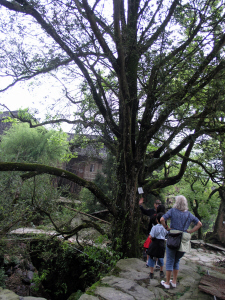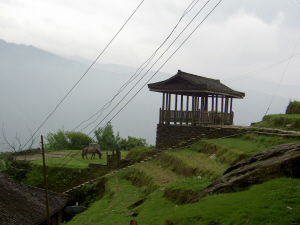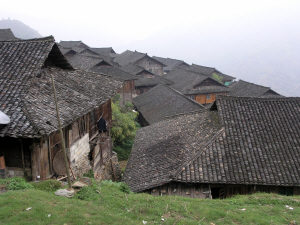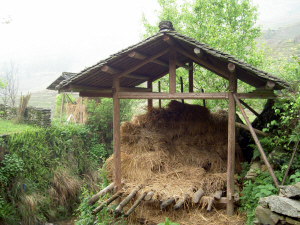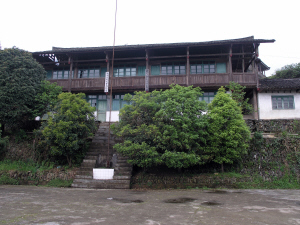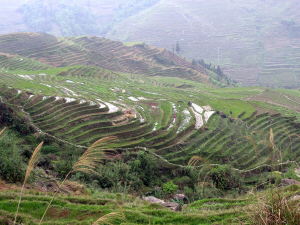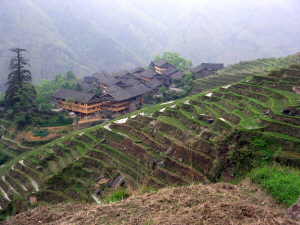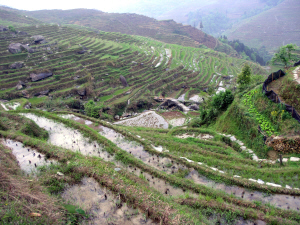|
Saturday April 11th, 2009 |
Longsheng, Light cloud – Max: 20; Min: 17; Avg: 18 |
Apart from the fact that the countryside around Yangshuo is truly beautiful, the
other reason to return after such a short time was the rice terraces of
Longsheng. Longsheng is situated a couple of hours drive north of
Guilin, so a three hour drive from Yangshuo. We woke early, both Steven and Daji
having even light breakfasts this time. We said our goodbyes to the staff and to
Jessie, who wasn't going to be with us on this part of the trip.
The weather was grey and it looked
like rain as we started the three and a half hour trip to Longsheng. We expected
to take the highway so we could save time, but the driver took the main Yangshou
to Guilin road - probably to save on the highway tolls - which took ages. We
joined the highway just south of Guilin and stayed until we had to take the
mountain road to Longsheng. The last
1,5 hours are uphill on a fairly small road, with occasional stops because of
landslides and fog – at times with near zero visibility. As soon as we passed to
top the drizzle and fog disappeared and a nice sunny day appeared. Again it was
a beautiful and fertile area.
We picked up our guide for the day, Danny, and carried on to Ping An,
overlooking the rice terraces – in fact the last 15 minutes up to Ping An take
place up a steep hill on foot. Many people stay overnight in Ping An, in which
cases old ladies, for a small fee, carry your luggage up to the hotel in baskets
on their back!
Reaching the village we started by taking lunch – Daji still only on soup as he
still wasn’t feeling well. The village is a Zhuang minority village and very
pretty – almost alpine in nature with lots of wooden houses.
After lunch we walked through the village and set off through the amazing countryside.
Danny told us that the terraces were built during the Yuan Dynasty and date
back 800 years. They were built because the minorities that lived in this area
were poor and had very little possibility to grow crops, so they were told to
build narrow terraces along the south facing mountain sides. Many of the
terraces are less than a meter wide, but gave the people the ability to grow
crops - not least rice – a perfect
example of nature and labour.
Today many of the terraces aren't cultivated - the people that own them earn far
more from tourists than growing rice. Some of the terraces are cultivated by
labourers on behalf of the owners. It wasn't the perfect time of year - June is
evidently when the terraces are flooded with water and which gives some amazing
sights and pictures. We were lucky that the weather was good - Danny told us
that he was here a few days earlier and the whole place was covered in fog. We
were lucky, the weather was fine throughout the day as we walked along the small
paths through the terraces.
We were more or less alone as we walked up to the two scenic
spots: “Nine Dragons and five tigers” and the “Seven stars accompanying the
moon" – the views were spectacular. Some of the terraces were under water,
others weren’t, but the views were still unbelievable - even though they
are supposed to be even more spectacular when all the paddy fields are under
water in May/June.
Danny was an able guide – knowing all the paths and was interested in gardening,
which made him a hit with Lene. However he was a terrible time keeper – we were
always an hour to the main road where we would be picked up – it turned out that
the first time he answered 3 hours, we were actually 3 hours away.
Apart from the fantastic scenery, the other big attraction was the fact that
the local women have extremely long hair and only cut it twice during their
lifetime – using the cut-off hair to help make up their hair-do. The hair is
always set-up after they are married. Yanmei had her
picture taken with one of the women, who, for a fee, showed us he hair - it went
from head to toe.
Past the two main scenic spots we walked to Long Ji village, not as picturesque
as Ping An but certainly more authentic, including the wooden gate that signified the
entrance to the village.
The views continued to be amazing, but we now had little time to enjoy them –
that last two hour trek downhill along very small paths (or often just stepping
stones), which had to be completed in an hour in order for us to be able to
reach the airport in due time. We were hot and exhausted when we finally made
the main road. Daji had been ill, only eaten soup and toast for two days - but
was rarely more than two steps behind the guide. It's amazing where he gets all
that energy from!
Back over the mountains towards Guilin, and it was still foggy and raining at
the top - it must have rained and been foggy all day. We made it to the airport
with time to spare, and caught the flight to Beijing – arriving in the capital
just before midnight, this time at the new airport.
The taxi couldn’t find the hotel and when we finally arrived they’d given our
room to somebody else, and we ended up sleeping in two single rooms at each end
of the hotel. Steven was very angry, not least at the attitude of the duty
manager (Steven later wrote a letter of complaint). Again Lene slept badly - but
this time she wasn't up and about next morning - the trip down the mountain had
probably dehydrated her and she rested all Sunday.
NEXT
DAY (12th)
|















